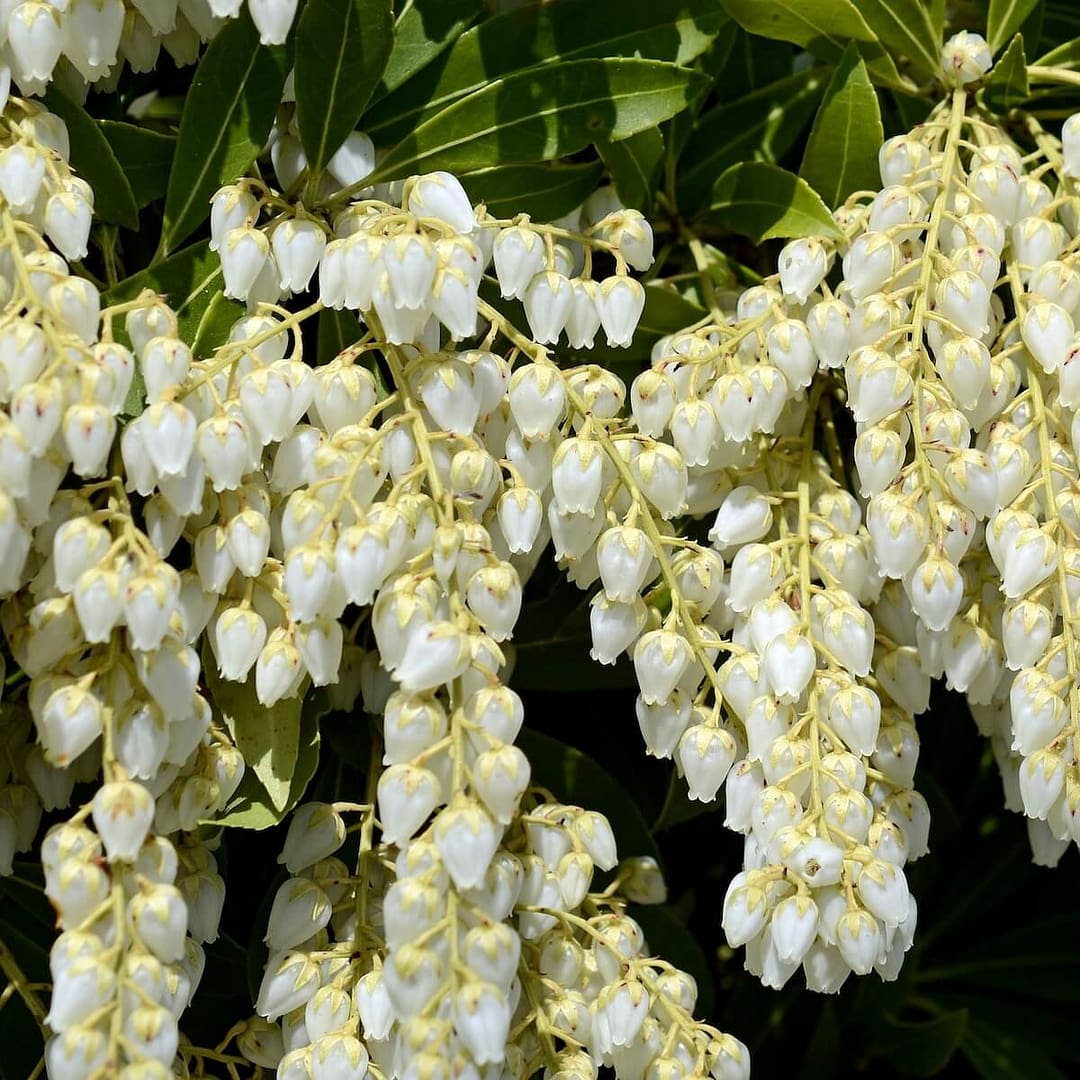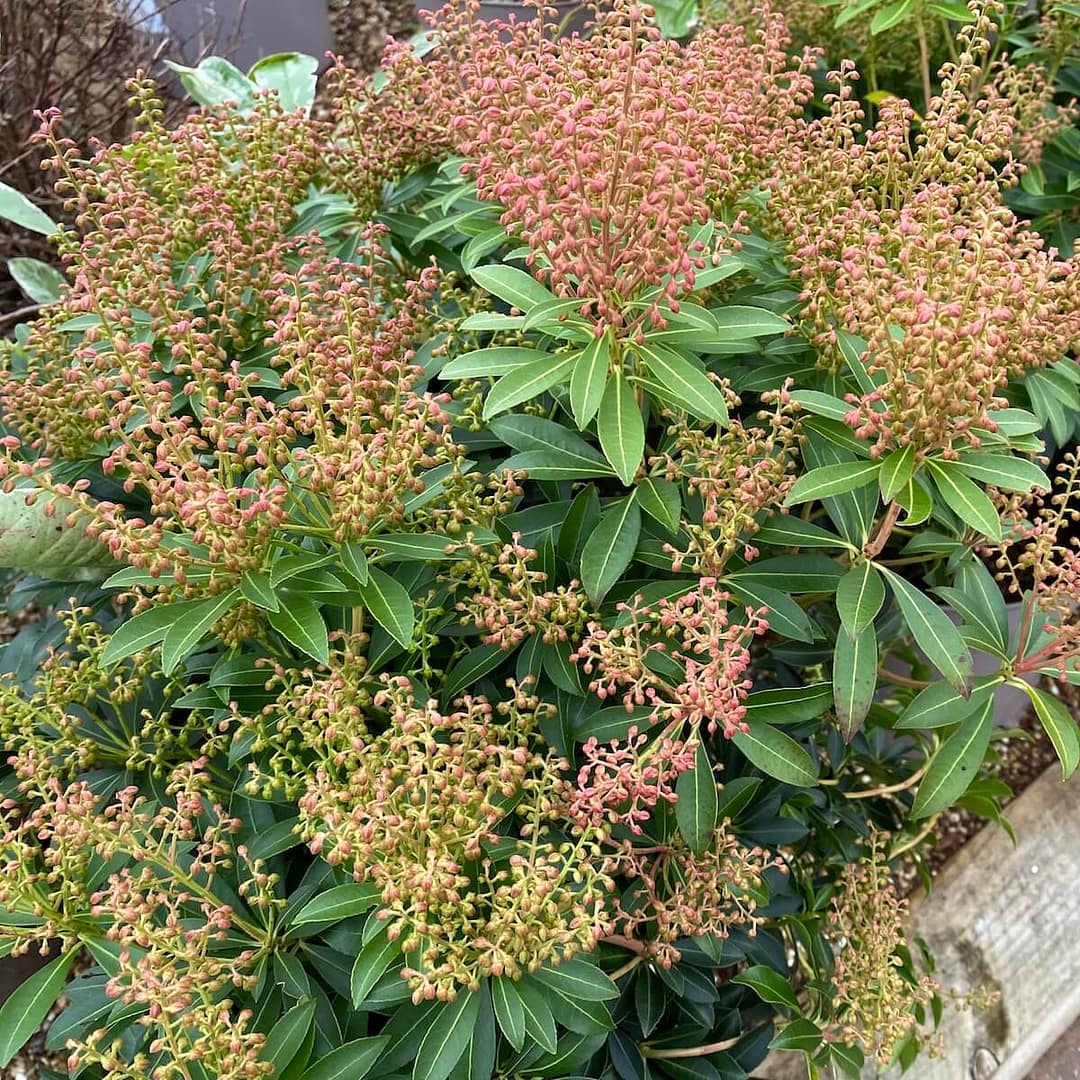
Position
- Partial shade to full sun
- Sheltered from cold winds
- Morning sun and afternoon shade ideal
- Protection from harsh afternoon sun
Hardiness
- Hardy down to -15°C (5°F)
- Suitable for most UK gardens
Soil Type
- Moist but well-drained soil
- Rich in organic matter
- Acid soil essential (pH below 6.5)
- Will not tolerate lime or alkaline conditions
Soil PH
- Acid soil essential (pH below 6.5)
- Will not tolerate lime or alkaline conditions
- Grab a soil test kit and ensure the perfect conditions for growth
Height
- Height: 90cm (3ft)
- Spread: 90cm (3ft)
Seasons of Interest
- New growth emerges bright red in spring
- Mature foliage is glossy, dark green
- White lily-of-the-valley-like flowers, March to May
- Evergreen year-round interest
- Bronze-tinted young growth
- Long-lasting flower display
Additional Notes
- Excellent choice for woodland gardens
- Perfect companion for rhododendrons and azaleas
- Apply ericaceous mulch annually
- Water with rainwater where possible
- Can be grown in containers using ericaceous compost
- Minimal pruning required – just remove dead or damaged growth
- May need protection from late frosts when in flower
- Feed with ericaceous fertiliser in spring
- Avoid planting too deeply
- Good choice for shady borders
Pieris japonica ‘Debutante’: A Graceful, Compact Shrub for Year-Round Elegance
If you want to add a touch of timeless beauty to your garden — something elegant, compact, and ever so easy to live with — then allow me to introduce you to Pieris japonica ‘Debutante’. This delightful little shrub ticks so many boxes for the modern gardener. It’s evergreen, compact, charmingly floral in spring, and low maintenance. What more could you want?
Whether you’re planning a new bed, freshening up a container display, or looking for a reliable garden performer that won’t take up too much room, ‘Debutante’ could be the answer.
Why You’ll Love Pieris japonica ‘Debutante’
Pieris japonica — often called Japanese Andromeda — is a true spring gem. The ‘Debutante’ cultivar has earned itself a loyal following thanks to its dense, tidy growth habit, rich evergreen foliage, and those show-stopping clusters of ivory-white bell-shaped flowers that dangle gracefully in spring.
These dainty blooms appear in March and can last right into May, providing a welcome lift to the garden when many other plants are still waking up. They also attract pollinators such as bees and early butterflies, which is a lovely bonus.
But even when not in flower, ‘Debutante’ holds its own. Its glossy, dark green leaves give a fresh, bright look throughout the year, adding texture and structure to beds, borders, or patio pots. At full maturity, this shrub remains pleasingly compact, usually reaching around 90cm (3ft) in height and spread, so it’s ideal for smaller gardens or even shaded balcony spaces.
It’s no wonder it has the prestigious RHS Award of Garden Merit, a mark of excellence that confirms its reliability, attractiveness, and ease of growing in British gardens.
Getting the Conditions Just Right
Pieris japonica ‘Debutante’ is part of the ericaceous family, which means it loves acidic conditions. Before planting, it’s a good idea to check your soil pH. If unsure whether your soil is acidic or alkaline, pick up a simple soil testing kit or meter.
In the Garden:
If you’re planting directly into a border, dig in plenty of well-rotted manure or ericaceous compost. This helps improve the soil’s structure and fertility. Pieris prefers moist but well-drained, acidic soil, and the organic matter will help retain just the right amount of moisture without becoming waterlogged.
After planting, sprinkle a slow-release fertiliser (formulated for ericaceous plants) around the base. Add a generous layer of mulch — pine bark, leaf mould, or composted bark are all excellent choices. This will help suppress weeds, conserve moisture, and keep those roots calm and happy.
In a Pot:
For container growing, always use ericaceous compost. This will provide the correct acidity and nutrients to keep your plant thriving. Choose a large pot with good drainage holes, and raise the pot slightly off the ground using pot feet or bricks to avoid waterlogging during rainy periods.
Again, mix in a handful of slow-release fertiliser at planting time, and mulch the surface with fine bark or decorative gravel to help retain moisture and discourage weeds or moss. Be sure to water regularly — especially in hot weather or when the plant is in bloom — but allow the compost to dry slightly between waterings.
Where to Plant ‘Debutante’ for Best Results
Pieris japonica ‘Debutante’ is best when grown in light shade or dappled sun. While it can tolerate some sun, especially in cooler areas of the UK, it’s best to avoid hot, direct midday sun, as this can scorch the leaves and cause them to yellow or brown at the edges.
A sheltered spot, perhaps near a wall or under the canopy of light trees, is perfect. This makes it an excellent choice for a woodland-style planting scheme, which pairs beautifully with ferns, heucheras, rhododendrons, and other shade-lovers.
It’s also lovely in a mixed border, where its evergreen foliage provides a reliable backdrop to more fleeting flowers. Or try it near your front door or patio — that way, you’ll enjoy its spring flowers up close!
When and How to Plant Pieris japonica ‘Debutante’
The best time to plant is in spring or autumn, when the soil is still warm but there’s usually enough moisture to help your plant settle in comfortably.Here’s a quick step-by-step for planting in the ground:- Dig a generous hole, at least twice as wide and just as deep as the root ball.
- Incorporate plenty of well-rotted manure and ericaceous compost into the planting hole.
- Place your plant so it sits at the same depth as in its pot.
- Backfill with the improved soil mixture, firm in gently, and water thoroughly.
- Apply a mulch around the base and feed with an ericaceous slow-release fertiliser.
- Choose a sturdy pot with excellent drainage.
- Fill with ericaceous compost, mixed with grit for drainage.
- Set the plant at the correct depth and water it well.
- Top with mulch or decorative bark to retain moisture.
- Keep an eye on watering through the warmer months — pots dry out faster than borders.
Caring for Pieris japonica ‘Debutante’ Year-Round
This little shrub is wonderfully undemanding once it’s established. Here’s a quick breakdown of seasonal care:
Spring:
- Enjoy the flowers from March to May
- Water during dry spells
- Apply a slow-release fertiliser in early spring
- Lightly prune to remove dead, diseased, or straggly growth after flowering
- Gloves on! All parts of Pieris are toxic if ingested, so be cautious when handling.
Summer:
- Water regularly, especially if growing in a pot
- Check foliage for signs of yellowing — this could indicate a pH problem or iron deficiency
- Consider a liquid feed if the plant is looking tired.

Autumn:
- Check for congested growth and remove any damaged stems
- Add a fresh mulch layer for insulation and weed suppression
- Protect potted plants if heavy rain or frost is expected.
Winter:
- ‘Debutante’ is hardy but prefers a sheltered spot away from harsh winds and extreme cold
- In containers, wrap pots with bubble wrap or fleece if temperatures drop below freezing
- Enjoy the flower buds, which often start to form by late autumn or early winter, ready to burst into bloom next spring.
Common Issues and Troubleshooting
If you notice your plant yellowing or looking a little off-colour, it could be a sign that the soil is too alkaline or lacking in nutrients. A dose of ericaceous plant feed, some sulphur chips, or a top-up with ericaceous compost can work wonders.Lace bugs or leaf spots can occasionally be a problem, but these are rare and generally don’t affect healthy, well-cared-for plants. To keep things clean and tidy, ensure good air circulation around the shrub, avoid overhead watering, and remove any fallen leaves in autumn.From Darren’s Patch
I’ve always loved Pieris because its young spring foliage lights up the garden with rich reds and bronzes, but ‘Debutante’ brings something different. What sets it apart for me are the elegant, lily of the valley-like flowers that appear each spring — dainty, ivory-white bells that never fail to lift the space around them. In my garden, I grow it in a generously sized container by the back door, where I can appreciate those blooms up close and enjoy the evergreen structure through the colder months. It’s a compact, beautifully behaved shrub that quietly delivers interest all year round without becoming demanding. If you’re after a reliable performer with authentic spring charm and year-round appeal, ‘Debutante’ is an excellent choice.
![]()
Key Points to Remember:
- Prefers partial shade
- Needs well-drained, acidic soil
- Water regularly, especially during dry spells
- Use ericaceous compost when planting in borders and containers
- Minimal pruning is needed
- All parts of the plant are harmful if eaten, so wear gloves when pruning
- Compact evergreen with beautiful spring flowers
- Check soil pH before planting
- Feed with slow-release fertiliser for ericaceous plants
- Ideal for borders, pots, woodland gardens, and foundation plantings
In short, Pieris japonica ‘Debutante’ is one of those charming, hardworking little shrubs that quietly delivers beauty year after year without demanding too much in return. Whether it’s lifting a gloomy corner, starring in a spring container, or simply giving you something pretty to look at all year round, it’s one plant that absolutely deserves a spot in your garden.
Check out the RHS article here.
Don’t miss Houttuynia cordata Chameleon — it might just be the plant you’re looking for.
For more information on Shrubs for your garden, please click here.
